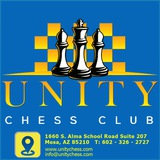Black’s queenside is defenceless, with his light-squared bishop presenting an especially poor impression.
31...Nf4 32.Rdc1 Rg6 33.Bd1 Qd7 34.Bg4 Qe7 35.Nf5 Qg5 36.Bxf4 Qxf4 37.Qxb7 1-0
Unity Chess Club
Samuel Reshevsky Tigran Petrosian Zurich 1953 Black to move
Black’s position looks critical, as he lacks space and his pieces are uncoordinated. White threatens the break e5-e6, and also wants to play Bg4-f3, with the threat of d4-d5. But there is a brilliant way to change the contours of the game:
This is playing on the wrong flank, but even after 26.Bxe6 Qxe6 (weaker, by analogy with the game, is 26...fxe6, because of, say 27.Rf1 Ne7 28.Rg3, with the intention of including the h-pawn in the attack) 27.Rg3 Ne7 28.h4 Nd5, Black obtains positional compensation for the exchange, although not fully adequate.
26...Ne7 27.Bxe6 fxe6 28.Qf1 Nd5 29.Rf3 Bd3 30.Rxd3 cxd3 31.Qxd3 b4 32.cxb4 axb4 33.a5 Ra8 34.Ra1 Qc6 35.Bc1 Qc7 36.a6 Qb6 37.Bd2 b3 38.Qc4 h6 39.h3 b2 40.Rb1 Kh8 41.Be1
Even in the case where, after the exchange of the b2- and a6-pawns, White does not lose the d4-pawn, Black’s positional compensation will be sufficient, so a draw was agreed.
Unity Chess Club
Artur Jussupow 2630 Alexander Beliavsky 2690 Frankfurt rapid 1998 Black to move
It would appear that the position is roughly equal: the pawns are equal, and the opposite-coloured bishops enhance the drawing tendencies. But these considerations would only be true if queens were not on the board. All the while they are, the possibility exists of a powerful attack on the white king.
Black finds a way to break up White’s pawn chain and get at the white king.
White will not manage to get his attack on the enemy king going. It was essential to switch to defence with 29.Kf3 gxf4 30.exf4, although here too, Black has a serious initiative after 30...Qd4 31.Qd2 Bc5.
